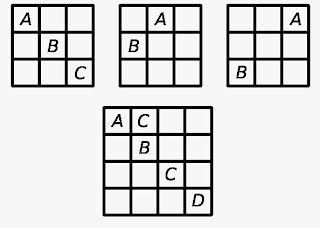Still cutting the paper pieces
With 1 cut, - 2 pieces, 2 cuts - 4 pieces, 3 - 7, 4 - 11, 5 - 16...(Recall triangular numbers: 1, 3, 6, 10, 15,... - do you see any connections?)
Even more cuttings
Can we cut a square with straight cuts? How about pentagon? pentagram?Of course we cannot cut the pentagram! It is not convex! Only convex figures can be done with straight cuts.
But there is a trick: fold paper! can you cut non-convex stars?
Other triangular numbers
More gallery guards:
how many you need to guard these galleries?
 |
| 2, 2, 3 and 2! |


















